How to properly plant a lemon at home so that it does not hurt and bear fruit
Grafting a lemon is the easiest way to make a tree bear fruit faster and feel like a breeder. Even on a wild plant grown from a seed, grafts of various varieties and hybrids and even other varieties of citrus fruits easily take root. And it is with lemon that the first vaccination experience is most likely to be positive.
Many people are scared to undertake this procedure, but, in fact, it does not involve a lot of money and time and is simple to do. The main thing is to choose the appropriate vaccination method and follow the step-by-step instructions. How to vaccinate lemon at home so that it bears fruit - read on.
The content of the article
Benefits of grafting lemon
Indoor lemon tree, seed-grown, Is a wild... It will produce small, tart and sour fruits. Moreover, the first fruiting is expected not earlier than in five years.
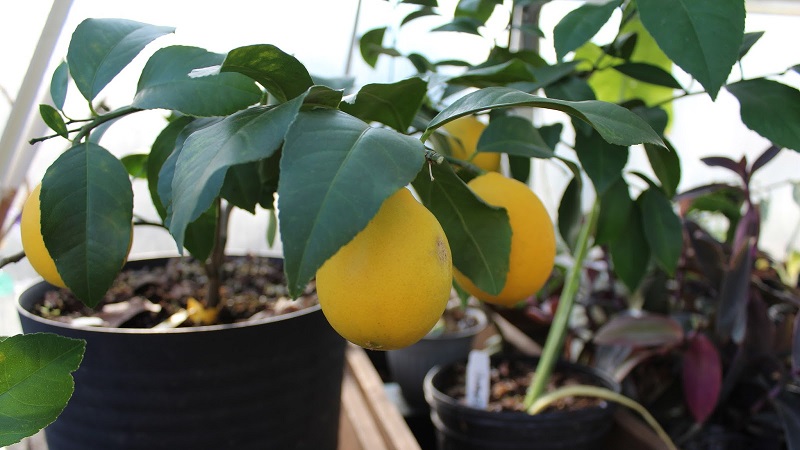
Grafting lemon is a process that requires following instructions and knowing a number of nuances.... Therefore, many novice growers refuse it, preferring to wait for fruiting for a long period.
In fact, even a person who grows a houseplant for the first time can cope with grafting a lemon. A grafted tree has several advantages over an ungrafted tree.:
- Approaching fruiting. A graft taken from a tree that has already borne fruit is capable of producing a crop in 1-2 years. At the same time, the chances that lemon will bear fruit at all are significantly increased.
- Varietal characteristics. From seeds from fruits purchased in the supermarket, you can to grow only the wild. If you graft a branch of any variety to such a plant, the fruits will have varietal or hybrid characteristics. Accordingly, they will be larger and tastier.
- Another plant. Not only lemon branches are grafted onto a lemon tree, but also scions taken from other citrus plants. This allows you to grow an orange or lime from a lemon. If you leave the lemon branches, you get a tree that will bear fruit both lemons and other citrus fruits.
In most cases, the graft takes root. Problems arise only when the vaccination procedure is violated.
Preparation for vaccination
Before grafting lemon at home, you should prepare for this procedure. After all during the vaccination process, all tools and materials should be at hand.
Materials and tools
Vaccination of a lemon does not cost any money. For this procedure, you will need materials and tools.that every gardener has at home:
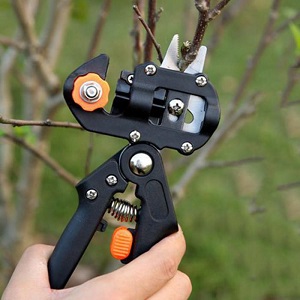 Pruner or sharp paint knife. These tools make even cuts on the plant. Before use, they are disinfected with alcohol or a dark pink solution of potassium permanganate. Another decontamination option is to hold the metal part over a fire.
Pruner or sharp paint knife. These tools make even cuts on the plant. Before use, they are disinfected with alcohol or a dark pink solution of potassium permanganate. Another decontamination option is to hold the metal part over a fire.- Special garden tape. She attaches the scion to the stock. Often, the special summer is replaced with ordinary construction tape.
- A cut of pure cotton material. The scion is wrapped in it.
- Garden var. Used to disinfect sections. Accelerates the regeneration of plant tissues.
- Film, bag, cut bottle to create a mini-greenhouse for the grafted plant.
There are special grafting knives and secateurs... They get the most even cuts, which is why the graft takes root faster.
Council. If you don't have a garden tool, a surgical scalpel can easily replace it.In a pharmacy, it costs less than a paint knife in a hardware store.
Scion and rootstock preparation
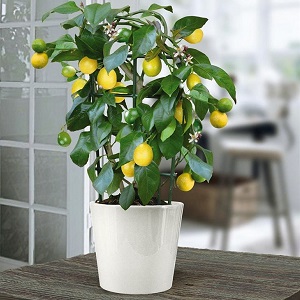 The best rootstock (base) is a seed-grown lemon... Such a seedling has increased endurance, and new tissues quickly grow to it. Therefore, the chances that the scion will take root are high.
The best rootstock (base) is a seed-grown lemon... Such a seedling has increased endurance, and new tissues quickly grow to it. Therefore, the chances that the scion will take root are high.
The rootstock must be at least one year old... Branches are also planted on older plants. In this case, you do not have to cut off all the shoots.
Before starting grafting, the tree is transplanted... At least two months must pass between these procedures.
The day before vaccination, lemon is watered abundantly and fed with a growth stimulant... It is important to make sure that the tree is absolutely healthy. The trunk must be cleaned of dust and husks. It is better to wash the lemon in the shower a few days before the procedure.
One-year-old branches are used for scion... They should have a hard but resilient bark. The scion must contain at least 1 bud. If the splitting method is used, branches with 2-3 buds are selected.
The tree from which the branch is separated must already bear fruit several times... Otherwise, it will not be possible to bring the harvest closer. Any citrus plant will do. The most difficult thing is to cross a lemon and a tangerine, since the latter takes root slowly.
Use the end of the branch for grafting... It should have enough kidneys for the specific vaccination method. The graft is cut at an angle in one quick motion to get a smooth cut. The place from which the branch was cut is covered with garden varnish.
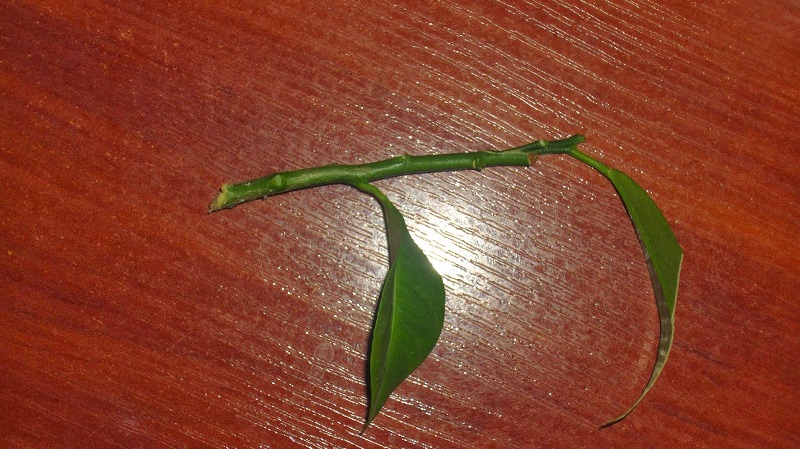
Lemon is planted in late May or April... It is during this period that the most active sap flow is observed, which allows the branch to quickly grow to the base. Vaccination is also possible in summer, but not in winter or autumn.
If the procedure is postponed for some reason, the cut stalk is wrapped in a damp cloth. This will keep it from drying out.
Note! Vaccination is recommended on cloudy days. The absence of direct sunlight and high humidity will help the scion and stock to grow together.
Lemon grafting methods
There are two ways to graft a lemon... They are equally popular and each has its own merits.
You need to choose the method that seems easier in the case of a particular plant. Better to try both options and choose the best one for yourself.
Copulation
Copulation involves grafting a lemon sprig into the cleft... This method is considered the easiest to implement. However, it is not suitable for adult lemons. It is used for yearling plants.
Correct vaccination instruction with copulation method:
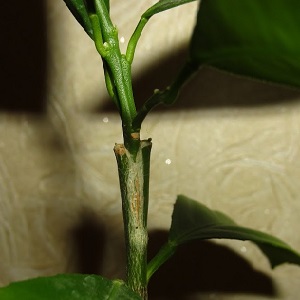 The trunk of the scion is cut with a pruner so that a third of the plant remains above the ground. It will not have leaves and buds.
The trunk of the scion is cut with a pruner so that a third of the plant remains above the ground. It will not have leaves and buds.- A split 1.5-2 cm deep is made in the center of the scion. For this, it is convenient to use a scalpel or a painting knife, moving the blade with swaying movements. It is important not to damage any part of the split.
- Such a distance retreat from the edge of the branch to be grafted so that 2-3 leaves remain on the top and there are 2-3 living buds. The cut is made at an angle of 45 °.
- The lower part of the scion is sharpened on both sides at an angle. You should get a thin wedge equal to the length of the rootstock depth. It should be thin enough so that the scion does not crack.
- If the leaves on the rootstock are large, they are cut in half. The middle leaf plates are cut by a third. Small leaves do not touch. If there are greens not only on the top of the scion, it is cut off.
- The rootstock is inserted into the scion as deep as possible, widening the cleft with a knife blade. In this case, it is important that the scion does not crack, and that the rootstock adheres as tightly as possible to its walls.
- The junction is tightly wrapped with adhesive tape, leaving no open areas. It is important not to overtighten the trunk in order not to disrupt the sap flow.
- Such a distance retreat upward from the junction so that 2-3 buds remain on it. The rest of the cutting is cut at an angle. A garden pitch is applied to the cut site.
- The tree is watered and sprayed abundantly.A plastic bag is put on top, which is tied around the pot.
The bag should remain on the plant until the grafted twig takes root... This will be evidenced by the germination of shoots.
After the first shoots appear, the film is removed for several hours a day.gradually increasing this time. When the lemon gets used to the new conditions, the bag is removed completely.
Budding
Budding involves grafting a lemon with a bud or eye... This is the name of the junction of the leaf and the trunk, in which a new bud is formed.
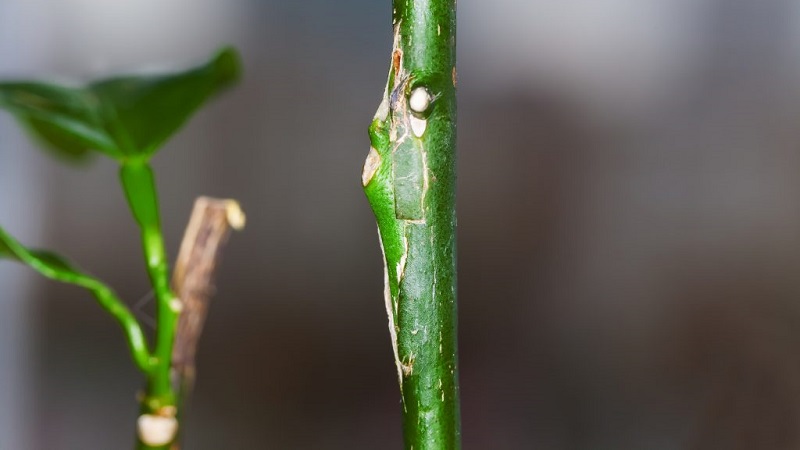
The advantage of budding is that this method is applicable even to adult plants.... It does not require cutting off the top of the tree and keeping only the trunk.
Reference. When they want to cross a lemon and another citrus so that different fruits grow on the same tree, they use budding.
They carry it out in two ways... One of them is called budding in the T-shaped incision, the second - in the butt.
In a T-cut
The method is good because the bark tightly presses the kidney. Thanks to this, the scion takes root faster.:
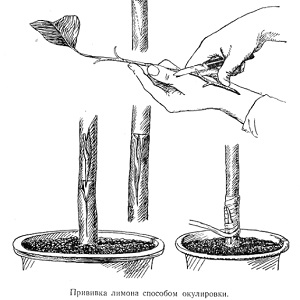 From the surface of the soil along the stem of the lemon, 6-8 cm recede upward. At this level, a horizontal incision is made 1.5 cm long and a vertical incision 2.5 cm long. All layers of the bark are cut so that it is separated from the stem.
From the surface of the soil along the stem of the lemon, 6-8 cm recede upward. At this level, a horizontal incision is made 1.5 cm long and a vertical incision 2.5 cm long. All layers of the bark are cut so that it is separated from the stem.- A section with a bud and a leaf is cut vertically from the mother plant. The graft should be 2.5 cm long and 1.5 cm wide. The leaf is torn off, leaving only the petiole.
- The graft is inserted into the cut on the lemon so that it completely goes under the bark and only the bud remains open.
- The junction is tightly wrapped with garden tape, avoiding open areas. Only the kidney should be on top of the tape.
- The lemon is watered abundantly. The pot with the tree is covered with a bag.
The package is removed, and the leaf petiole is torn off, only when the kidney takes root.
Vpklad
In this case, the stalk and trunk (or branch) have a cut at the same angle.... They are simply put together. The complexity of the method lies in the fact that you need to fix the two parts so that they fit tightly to each other, do not fall off and do not bend. It's not easy, especially for beginners.
Vaccination instructions in stock:
- 6-8 cm recede from the surface of the ground. At this level, a cut is made from top to bottom at an angle of 45 °, which should look like an oval fossa 2.5 cm long. It is important to try to make the cut site as even as possible.
- From another tree (fruiting), a scion is cut, on which there are 2-3 buds, also at an angle of 45 °. The leaf is torn off, leaving only the bud and the petiole. The thickness of the rootstock and the thickness of the scion must match. You need to hold the planting material by the petiole, without touching the cut.
- Slices of the scion and rootstock are combined as tightly as possible and tied with electrical tape so that there are no free areas. Only the kidney itself should be above the adhesive tape. Some gardeners use a toothpick, straight stick, or ice cream stick to secure the structure.
- The lemon is watered abundantly. Then cover with a bag, which is tied tightly around the trunk.
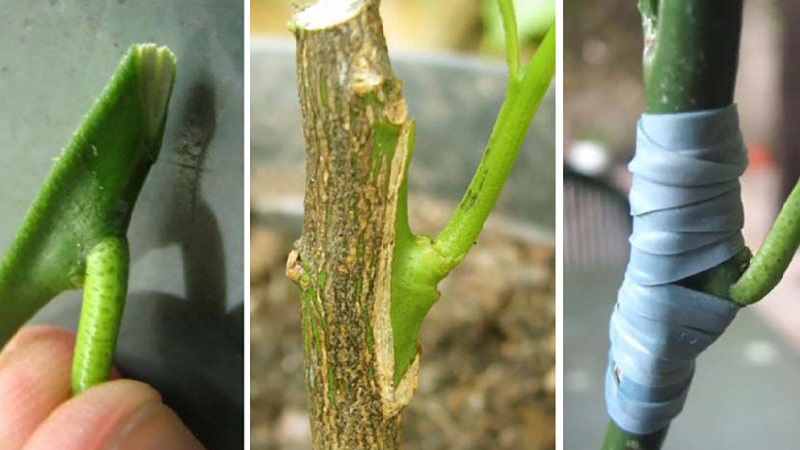
Remove the package only after the shoots begin to sprout on the scion... This indicates that the tissues have grown together.
After the bud takes root and the shoot appears, the lemon begins to airgradually removing the package completely. After that, break off the petiole remaining from the leaf. If you break off the petiole immediately, the scion may not take root.
Note! This vaccination is not always successful.
Caring for indoor lemon after crossing
During the growth of the slices, and also for some time after that, the lemon needs special care. It is as follows:
- The tree is placed in a shaded place. Direct sunlight will reduce the chances of a successful vaccination.
- Every day the bag is opened for 10-15 minutes.
- The soil is moistened as it dries. The ground part of the lemon is also sprayed. Use settled water at room temperature.
- To speed up the growth of the scion, it is recommended to cut off the part of the tree 10 cm above it. When shoots appear on the graft, the shoots around it are removed.
- At the time of vaccination, it is recommended to tie a lemon to a support.
Read also:
Useful Tips
For the vaccination to be successful, it is important to know some of the nuances:
- The most common cause of unsuccessful vaccination is air trapped in the junction of the slices. This happens if the cuts did not fit together or the adhesive tape was not wound tightly enough.
- In order for the stalk or bud to take root, it is important that bacteria do not enter the cut. You need to work with sterile gloves, and disinfect the tool (pruner and knife). The slices are not touched by hands.
- In order to create optimal moisture under the bag, it is recommended to place wet cotton wool in the pot. This will help reduce the amount of watering.
Conclusion
Lemon grafting is optional but desirable. It significantly brings the first fruiting closer, allows you to make a seed-grown plant varietal and gives you the opportunity to experiment with crossing.
Don't be afraid of being vaccinated with citrus fruits. This culture quickly and easily fuses tissue. The main thing is to choose the appropriate method, take into account all the nuances and act according to the instructions.